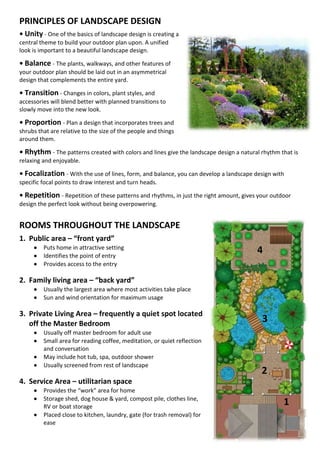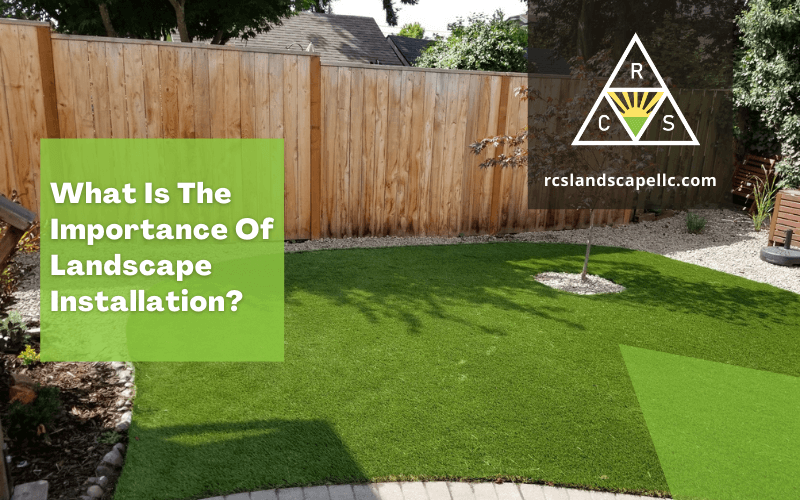The Buzz on Landscape Design
The Best Guide To Landscape Design
Table of ContentsWhat Does Landscape Design Mean?Not known Details About Landscape Design Unknown Facts About Landscape DesignThe Buzz on Landscape Design
When designing a household landscape, the most essential action is to place a plan on paper. Creating a plan of attack will conserve you time and cash and is most likely to result in a successful style. A master plan is created with the 'style process': a step-by-step approach that takes into consideration the environmental problems, your needs, and the aspects and principles of layout.The 5 steps of the design procedure consist of: 1) conducting a website supply and analysis, 2) establishing your demands, 3) producing useful layouts, 4) developing conceptual style plans, and 5) attracting a final design plan. The very first three steps develop the visual, useful, and gardening needs for the layout. The last two steps then apply those requirements to the development of the last landscape plan.
This is a vital action for both plant choice and placement and situating household activities and features. It is necessary due to the fact that the exact same climate problems that impact the plantstemperature, humidity, rain, wind, and sunlightalso impact you, the customer. The following action is to make a checklist of your needs and desiresthis helps you identify how your yard and landscape will certainly be used.
The practical diagram is then made use of to situate the activity areas on the website and from this diagram a theoretical plan is developed. The last action is a last design that includes all the hardscape and growing information that are needed for installation. Throughout the layout process there are 10 vital things to take into consideration: for plant selection and activity location by considering what you desire and need to aid determine forms and organize spaces by marking activity locations and relating to elements for both the atmosphere and the individual by utilizing massing and layering methods such as shift locations and centerpieces in the products, the shades, and the surface structures for the growth and maintenance of plants by using sustainable layout practices An extensive inventory and evaluation of the website is essential to identify the environmental conditions for plant growth and the most effective use the website.
A Biased View of Landscape Design
The kind of dirt establishes the nutrients and moisture readily available to the plants. It is constantly best to utilize plants that will thrive in the existing dirt. Soil can be modified, modification is usually costly and the majority of times inefficient. Existing plants can supply clues to the soil type. Where plants expand well, keep in mind the dirt conditions and utilize plants with similar growing requirements.

Sun/shade patterns, the amount and length of direct exposure to sun or shade (Figure 1), develop microclimates (often called microhabitats) - Landscape Design. Recording website problems and existing greenery on a base map will certainly reveal the location of microclimates in the backyard. Plants generally fall under 1 or 2 of 4 microclimate categories-full sun, partial shade, shade, and this page deep shade
Landscape Design Can Be Fun For Anyone
Number 1. Sunlight and shade patterns. Credit Report: Gail Hansen, UF/IFAS It is vital to keep in mind all the current conditions on an accurate base map when doing the site inventory (Number 2). Utilities such as power lines, septic systems, underground utilities and roofing system overhangs identify plant place. Make use of a surveyor's plat of see this page your residential property for the limits and location of your home.

Budget plan problems consist of the materials, preliminary installation costs and the on-going upkeep expenses. Identify the time and money you want to take into keeping the plants and hardscape-be sensible concerning your intents and ability. Figure 3. Present use locations. Credit: Gail Hansen, UF/IFAS Figure 4. Proposed use locations. Credit History: Gail Hansen, UF/IFAS There are various landscape style themes- from basic to complex, however it is helpful to choose one to direct your plant and material selection.
Lots of people locate it helpful to search in gardening magazines and publications for ideas. This is a great begin, yet understand that the yards in the images were chosen due to the fact that they are impressive instances. Look at the images with a critical eye to gather ideas that you can adapt to your passion degree, your spending plan and your website.
Determine if you intend to open your yard, close your lawn, or a little of both, to these views (Landscape Design). In other words, do you desire the yard to confine the room around you and relate primarily to your house, or do you want the yard to open sights and look outside, connecting to the surroundings? This will give you a starting point to believe regarding a motif
What Does Landscape Design Mean?
Every garden needs to have a form style, but not all gardens have a style theme. Several household yards have no specific style other than to mix with the house by duplicating details from the design such as web products, shade, and form.
In a type theme the company and shape of the areas in the backyard is based either on the form of your home, the shape of the areas between your home and the residential or commercial property borders, or a favored form of the property owner. The form style identifies the form and organization (the format) of the areas and the web links in between them.
